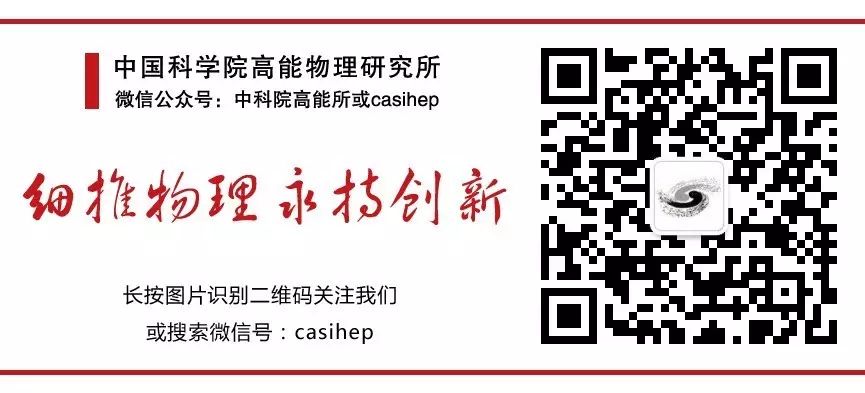■ Xiao Xi / Text
Many people know about the connection between the Internet and high-energy physics. In the late 1980s, several large-scale high-energy physics experiments were underway at the European Organization for Nuclear Research (CERN), with hundreds of scientists from dozens of countries participating. To facilitate their work, a system for information management and transmission was urgently needed to quickly, accurately, and conveniently exchange massive amounts of data over long distances. Tim Berners-Lee, a British scientist working at CERN, came up with a solution: he established an internal network (the World Wide Web) at CERN using the “Hypertext Transfer Protocol” to organically organize information made up of text, images, video, and sound using hyperlinks. Since 1991, this Internet technology has been widely used internationally, and today, at least 3.5 billion people worldwide are using the Internet (about half of the world’s population).
However, many people are unaware that another high-tech phenomenon that has swept the world—touchscreens—also has historical ties to high-energy physics.
In recent years, touchscreens have permeated nearly every field and are closely related to almost everyone: GPS systems, various control consoles, ATMs, cash registers, vending machines, ticket machines, medical monitors, game consoles, computers, smartphones… this technology is almost everywhere.
What is the connection between it and high-energy physics? Let’s take a look at the related story.
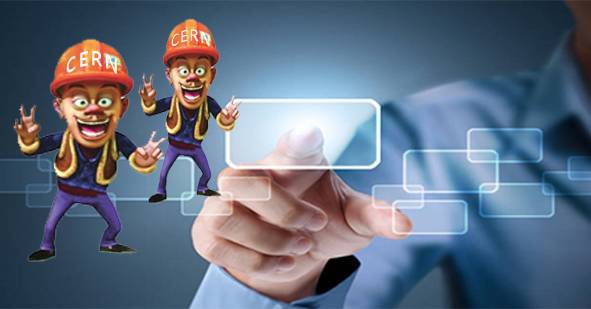
Decades ago, the world’s most imaginative science fiction writers had not even conceived of the touchscreen. Even more surprisingly, the touchscreen technology, which originated in the 1960s and 1970s, has developed at an astonishing speed to become an omnipresent daily technology, captivating the world. Looking back at its development history, there are indeed some little-known facts.
■ E.A. Johnson
It is generally believed that E.A. Johnson from the Royal Radar Establishment in Malvern, UK, was the first to propose the concept of touch display. In 1965, Johnson published a brief paper in the journal Electronics Letters titled “Touch Display: A Novel Input/Output Device for Computers,” in which he proposed a touch display as an input/output device: by touching a composite glass screen (with the inner surface coated with a layer of transparent metal oxide like indium tin oxide (ITO) and four electrodes at the corners), an induced electrostatic capacitance is generated, and the calculation of the touch action on the glass screen is achieved by measuring the change in capacitance (later known as capacitive touchscreens).
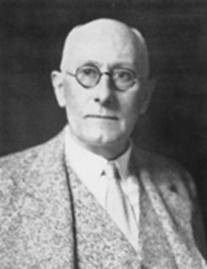
E.A. Johnson (Image from the Internet)
In 1967, Johnson turned his idea into reality by creating the first touchscreen in human history. He published a paper titled “Touch Displays: A Programmed Man-Machine Interface” in the journal Ergonomics, along with a photo and schematic of the first touchscreen. Johnson’s invention was awarded a US patent (US patent 3482241) in 1969.
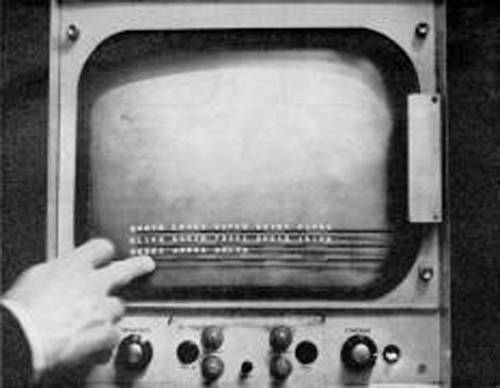
The first touchscreen made by Johnson in 1967 (Image from the Internet)
This screen, though somewhat bulky, could display magical effects; wherever a finger touched, the screen would light up at that point and record the finger’s position. At that time, this invention could only provide the location of a single finger touch; if multiple contacts occurred on the screen, the controller’s calculations would become confused, and the screen could only record two types of sensory information—contact or no contact—without being able to sense the pressure of the finger’s touch.
In 1973, this touchscreen technology was used by the British Civil Aviation Authority for air traffic control systems (which only required precise positioning), and it continued to be improved until the late 1990s.
■ George Samuel Hurst
Most articles in the media that introduce the history of touchscreen development jump directly from Johnson’s successful creation of the first capacitive touchscreen in 1967 to the invention of the more sensitive and intelligent resistive touchscreen by George Samuel Hurst in the USA a few years later.
At that time, Hurst was teaching at the University of Kentucky. He led a team using an old Van de Graaff electrostatic accelerator (a device that generates high voltage to accelerate charged particles using electrostatic principles) that could only work at night to study atomic physics. They had to stay in front of the screen all night, recording the positions where charged particles hit the screen and emitted light.
Hurst felt that this recording method was too time-consuming, tedious, and cumbersome. What to do? One day, he suddenly had a solution: place a conductive plate in front of the accelerator to collect the emitted charged particles and use electrodes around the conductive plate to read the X-Y coordinate information of the particle’s position, making it both efficient and accurate. This touchscreen sensor could input data quickly, completing calculations that originally took days in just a few hours. However, this device did not have a transparent screen and was relatively large.
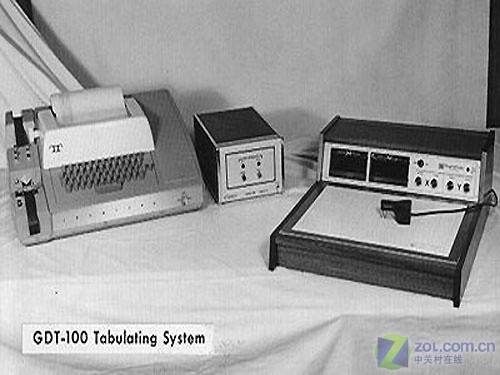
George Samuel Hurst (Image from the Internet)
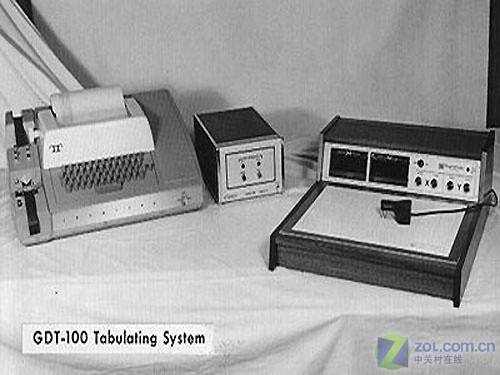
The touchscreen sensor invented by Hurst (Image from the Internet)
The University of Kentucky hoped that Hurst could apply for a patent for this, but he believed that the application was too limited to meet the patent standards, so he began to think about how to promote this method to other uses.
In 1970, Hurst came to work at the Oak Ridge National Laboratory (ORNL) in the USA. He invited several friends from different fields to work together in his basement during their spare time to study this matter. The initial idea was: if they could install a touchscreen on a computer monitor to interact with the computer, that would be great.
They used the same indium tin oxide (ITO) metal coating as Johnson’s capacitive touchscreen, but cleverly, they applied this metal layer to the back of a pressure-sensitive film. When a finger or a stylus touched the film, the metal coating at that position would contact the conductive plate behind it, causing an electrical current to flow. The conductive plate had a grid of axes that could accurately record the position of the current flow and distinguish between different levels of pressure applied.
In 1971, they applied for a patent for the resistive touchscreen and co-founded the company “Elographics.” The team members were responsible for sensors, conductive plates, and programming calculators, and they assembled the products in Hurst’s basement. From May to December of that year, they produced 25 finished touchscreen units, named “E-100.” In 1973, this technology was selected by Industrial Research magazine as one of the 100 most important new technology products of the year.
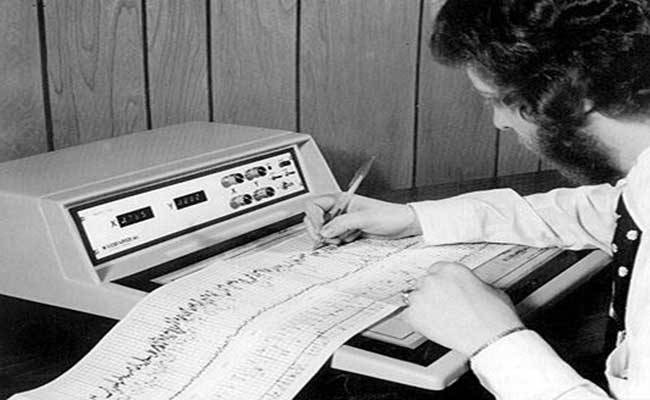
The E-100 touchscreen in use (Image from the Internet)
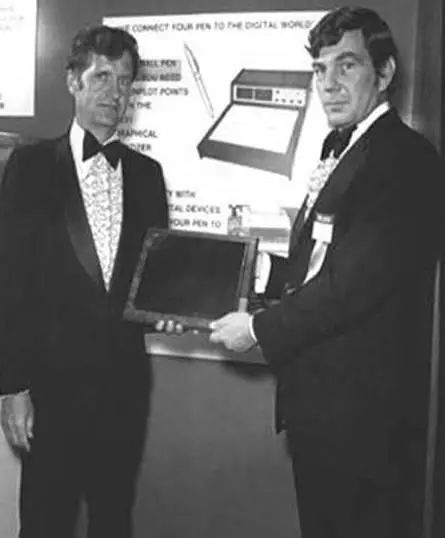
Hurst (left) receiving the 1973 New Technology Product Award as a company representative (Image from the Internet)
In 1974, Hurst designed the first transparent resistive touchscreen and continued to improve the relevant technology. During this period, the technology was mainly monopolized by the US military. It wasn’t until 1982, when Hurst’s company exhibited 33 televisions installed with resistive touchscreens at an electronics exhibition in the USA, that this technology truly entered commercial use.
Bent Stumpe & Frank Beck
The contributions of Johnson and Hurst to the invention of the touchscreen have left a significant mark in the history of touchscreen development, with Hurst even being referred to as the father of the touchscreen. However, another story about touchscreens from the early 1970s has been overlooked by many; some sources simply mention, “Two engineers from CERN invented the transparent touchscreen.”
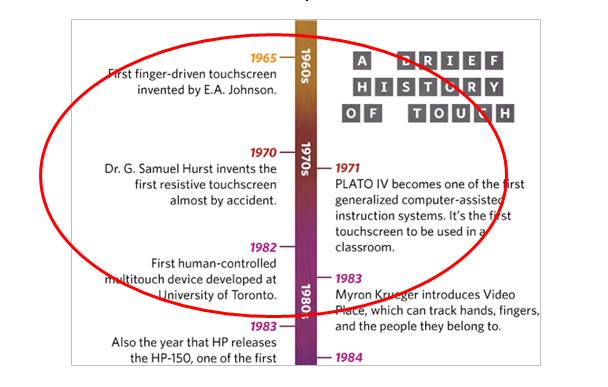
The history of touchscreen development in the media overlooks an important section (Image from the Internet)
What exactly is the story here? After some searching, reliable information was finally found:
An article titled “The First Capacitative Touch Screens at CERN” published in CERN’s publication CERN COURIER on March 31, 2010, and a detailed introduction to this process in CERN’s archival documents titled “Another of CERN’s Many Inventions.”
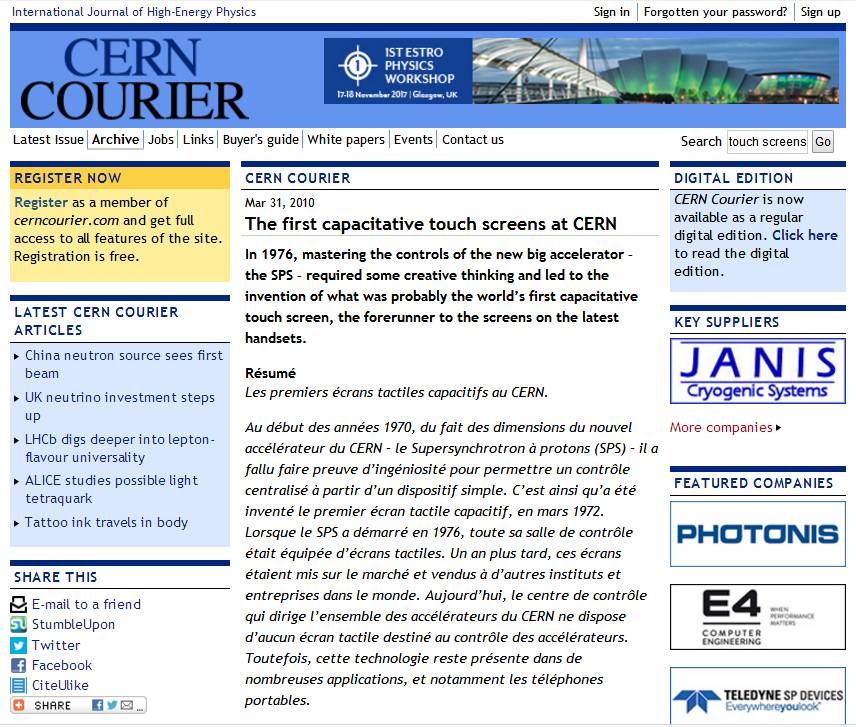
The first capacitative touch screens at CERN (Image from the Internet)
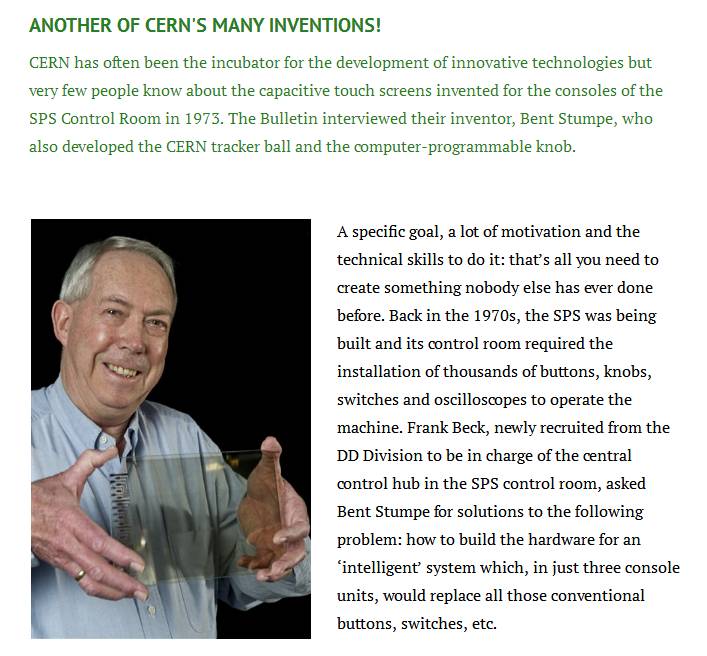
Another of CERN’s Many Inventions (Image from the Internet)
In February 1971, CERN began construction of the Super Proton Synchrotron (SPS), which had a circumference of nearly 7 kilometers, about ten times the size of the Proton Synchrotron (PS) that began operation in 1959. For the SPS, if the same control method as the PS was used, the central control center would need to install thousands of buttons, knobs, switches, and oscilloscopes, and all devices would be directly connected to the central control center via a single cable, which would be economically unfeasible.
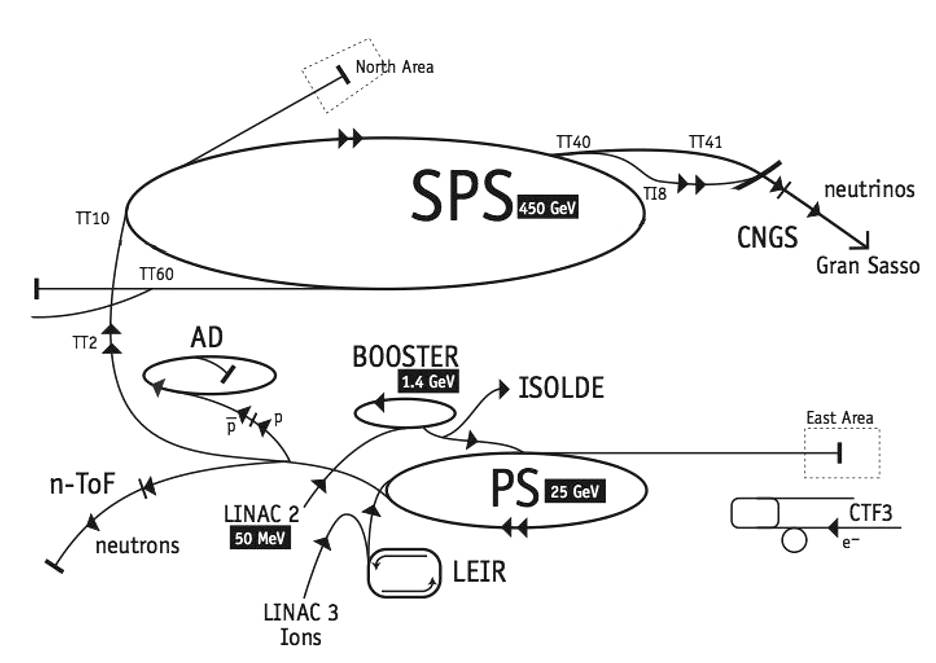
Diagram of the Proton Synchrotron PS and Super Proton Synchrotron SPS (Image from the Internet)
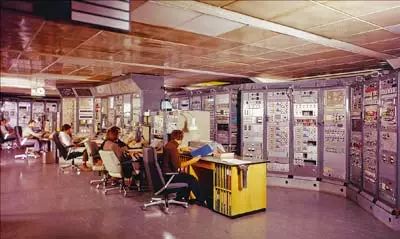
Control room of the Proton Synchrotron PS (1974) (Image from the Internet)
According to the design, various devices of the SPS would be controlled through three consoles, each with its own small computer. The new central control center needed to be able to integrate information from the three consoles and control thousands of parameters of the accelerator with a small number of knobs, switches, and displays. One of the primary tasks faced by the SPS control group in early 1972 was to find a practical and economical solution to this problem.
At that time, Frank Beck was the head of the SPS central control center, and Bent Stumpe was an engineer from Denmark (who had experience working in a television factory). Beck presented the problem to Stumpe: how to construct hardware with an intelligent system that could replace all the traditional buttons and switches of the three consoles?
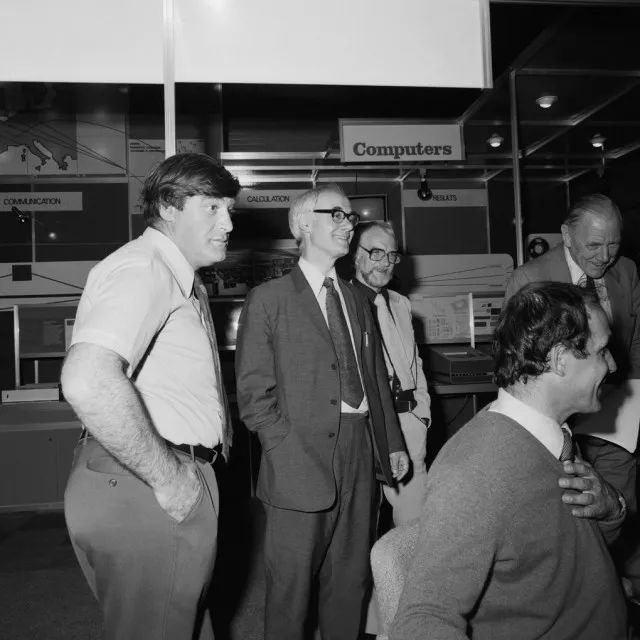
Frank Beck (left) (Image from the Internet)
A few days later (March 11, 1972), Stumpe proposed a solution (handwritten in a notebook)—to develop a capacitive touchscreen as an interactive computer display for the SPS central control center, displaying a fixed number of programmable buttons. Each programmable button was associated with a capacitor made of etched fine copper wire on the glass membrane. When a person’s finger touched a programmable button on the glass screen, it would increase the corresponding capacitor’s capacity by 10%. Special electronic devices would record these changes and bring a new set of labels, i.e., the next set of new commands available for the user to choose from.

Handwritten notes of Stumpe’s solution (16 pages) (Image from the Internet)
These programmable buttons, along with a trackball (which recognizes X-Y movement through the rolling of the ball and moves the pointer on the screen accordingly, similar to the principle of a computer mouse), and a programmable rotary switch, could form an “intelligent” control system based on a small computer to replace the thousands of buttons, switches, and oscilloscopes required by traditional control systems (the idea became feasible only after the development of computer-supported central control systems).
According to Stumpe’s later recollection, thanks to CERN’s ion sputtering technology at the time, it was possible to evaporate a thin layer of copper onto a sensitive and transparent polyester film, enabling the realization of capacitors made of etched fine copper wire, thus producing the first prototype of a capacitive touchscreen. A touchscreen with nine programmable buttons could work reliably; when a user touched a button, it could be recognized accurately. Beck presented this prototype to the SPS leaders, who immediately expressed their support for further research by Stumpe and others, even deciding to begin research on the corresponding computer control software without reliable testing, which was a significant risk at the time.
To further develop a practical touchscreen (with 16 programmable buttons), Stumpe and others collaborated with the Danish company FERROPERM, ultimately using a sturdier glass screen (reducing surface reflection), while another Danish company, NESELCO, participated in the production of the electronic modules needed to drive the touchscreen.
Initially, the touchscreen had only 16 fixed programmable buttons, each associated with different areas of the screen. Later, Stumpe expanded on his original concept, envisioning the development of an X-Y touchscreen that could sense positions corresponding to X and Y coordinates through two layers of capacitors. This method was more advantageous and allowed for a more flexible division of the screen. The X-Y touchscreen also involved new technologies for plating metal films on different substrates. After completing the prototype, CERN collaborated with other units to develop the product with funding from the Danish National Development Fund.
The SPS began operations in June 1976, and its control room was equipped with touchscreens—this was the world’s first large-scale device using this capacitive touchscreen technology. Such touchscreens were also used in other large devices and the modern control systems of larger colliders. Remarkably, some touchscreens operated for 20–30 years until CERN installed new control rooms for the larger Large Hadron Collider (LHC) in 2008.
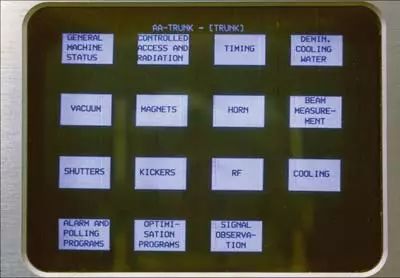
The touchscreen with 16 programmable control buttons (Image from the Internet)
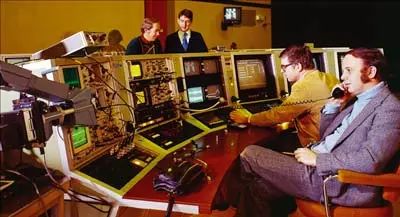
Control room of the Super Proton Synchrotron SPS (1977) (Image from the Internet)
Capacitive touchscreen in the SPS control room (Video from CERN’s official website)
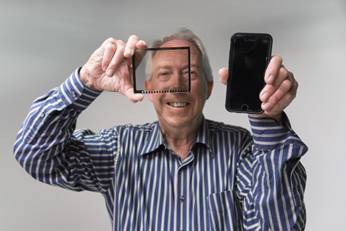
Stumpe with the touchscreen he invented (Image from the Internet)
This touchscreen technology was commercially applied as early as 1977, sold to other CERN users, other research institutions, and companies wishing to use this technology in their control systems. Users of this touchscreen technology are spread across the globe: on jet aircraft, at the Rutherford Laboratory in the UK, at the KEK high-energy accelerator research facility in Japan, at Mitsubishi and Toyota in Japan, and at various institutions in Denmark and Germany…
Note: After Steve Jobs returned to Apple in 1997, he ultimately decided to use capacitive touchscreen technology (which was still cutting-edge technology at the time) for the development of the iPhone. Compared to the resistive touchscreens commonly found in the market at that time, capacitive touchscreens had significant advantages. Resistive touchscreens required pressure from a finger or a special stylus to activate, and the top film had to be thin enough to meet the elastic requirements of contacting the lower film upon touch, making the film easily damaged. In contrast, capacitive touchscreens only require a touch without pressure to generate a signal, and they are protected by a glass layer, making them highly resistant to damage and contamination. By this time, capacitive touchscreen technology had evolved from early analog touchscreens to digital touchscreens, enabling multi-touch, which provided new opportunities for developing smartphone software. Jobs not only successfully transformed a company on the brink of bankruptcy into a giant in the consumer electronics industry but also truly brought touchscreens into the daily lives of the public.
■ Conclusion
With the continuous development of technology, touchscreens are becoming increasingly capable of accepting touch and gestures, achieving ultra-efficient human-computer interaction, and gaining broader applications in more fields. Today, touchscreen technology has permeated nearly every field and is closely related to almost everyone: GPS systems, various control consoles, ATMs, cash registers, vending machines, ticket machines, medical monitors, game consoles, computers, smartphones… this technology is almost everywhere.
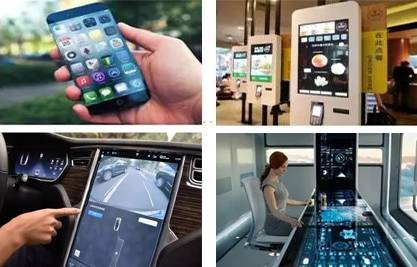
Ubiquitous touchscreens (Image from the Internet)
From the information presented above, the connection between touchscreen technology and high-energy physics has become quite clear.
It should be said that high-energy physics has always been an incubator for the development of innovative technologies, spawning a large number of high-tech innovations over the decades. These technologies were initially developed to solve internal problems of large experimental devices required for high-energy physics research. Ultimately, these technologies have greatly promoted the development of science and the economy, benefiting all of humanity.
Looking back at the story of CERN developing touchscreens is thought-provoking; the contributions of Stumpe and Beck should not be forgotten, and this experience should be prominently remembered in the history of touchscreen development.
References
1. Let’s Unveil the Mystery of Touch Technology!
http://www.elecfans.com/consume/402298.html
2. Ding Junjun, Xu Guoxiang, Chen Yuhua, Tian Minli, Overview of Capacitive Touchscreen Patent Technology, China Science and Technology Information, 2014, Issue 10, http://www.doc88.com/p-0691399543686.html
3. No Touch, No Where: 3 Minutes to Take You Through the History of Touchscreen Development http://www.sohu.com/a/140546126_732542
4. The Great Touchscreen: Leading the Sci-Fi World by Twenty Years! http://news.zol.com.cn/605/6055213.html
5. The Father of Touchscreens: A Historical Review of Inventions, http://digi.tech.qq.com/a/20080902/000107.htm
6. Apple’s iPhone: A Great Success at the Expense of Many, Big Technology Magazine, http://www.sohu.com/a/199269688_418353
7. Sam Hurst Touch, http://www.physics.berea.edu/documents/SamHurst.pdf
8. IET Digital Library: Touch Display—A Novel Input/Output Device for Computers
http://digital-library.theiet.org/content/journals/10.1049/el_19650200
9. Touch Displays: A Programmed Man-Machine Interface
http://www.tandfonline.com/doi/pdf/10.1080/00140136708930868?needAccess=true
10. Another of CERN’s Many Inventions!
http://cds.cern.ch/record/1248908
11. Frank Beck, Bent Stumpe, Two Devices for Operator Interaction in the Central Control of the New CERN Accelerator (Report), CERN, May 24, 1973
12. “The First Capacitative Touch Screens at CERN.” CERN Courier. 31 March 2010
http://cerncourier.com/cws/article/cern/42092
13. The Touching History of Touchscreen Tech
http://mashable.com/2012/11/09/touchscreen-history/#QjTLzvd2csqp
14. From Touch Displays to the Surface: A Brief History of Touchscreen Technology
https://arstechnica.com/gadgets/2013/04/from-touch-displays-to-the-surface-a-brief-history-of-touchscreen-technology/
15. CERN Touch Screen
https://www.symmetrymagazine.org/article/june-2010/cern-touch-screen
16. Six Stories Behind Touchscreens: How Jobs’ iPhone Turned It Around
http://www.21ic.com/news/ce/240498.htm
